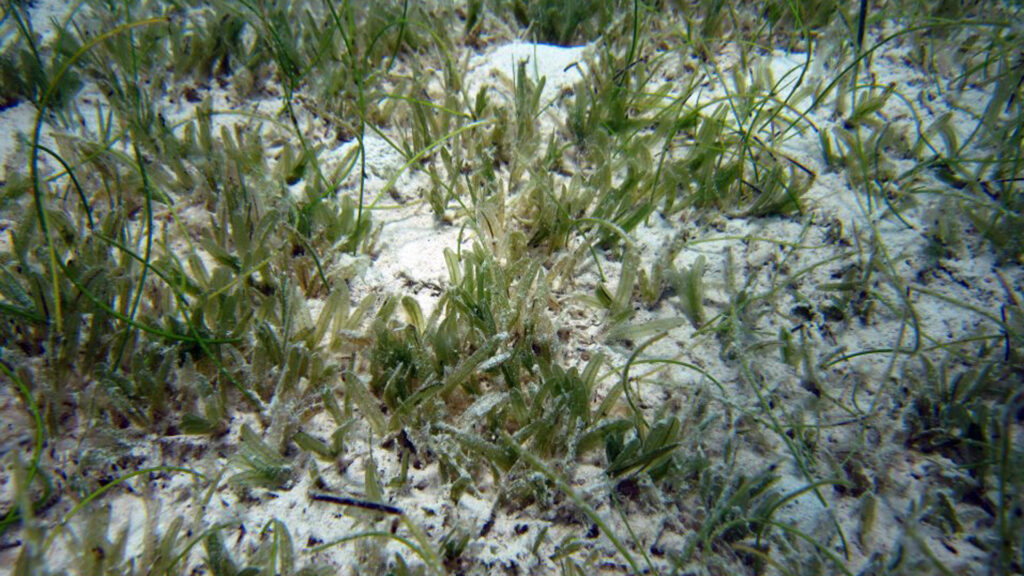By JoAnn Adkins, FIU News
An invasive species of seagrass has been on a steady march across the world, taking over ecosystems well beyond its native waters of the Red Sea, Persian Gulf and Indian Ocean. Scientists have long wondered when it would reach the waters off the coast of Florida. Florida International University scientists say that day has arrived.
FIU marine scientist Justin Campbell has positively identified Halophila stipulacea growing in Crandon Marina and nearby areas of Biscayne Bay. It is the first time this non-native species has been found in waters along the continental United States.
“I think this species could pose a considerable threat,” Campbell said. “There are several reports of it being able to outcompete native seagrasses in other areas across the Caribbean. It is plausible that this could also be true for seagrasses here in South Florida.”
A marina worker first noticed the seagrass last month and reached out to Campbell who conducted tests to determine the species. Halophila stipulacea first started spreading its distribution with the opening of the Suez Canal in the late 1800s, hitching rides on the anchors and other parts of boats. By the early 2000s, it was found in the Caribbean.

Healthy seagrass meadows are vital for healthy oceans. They are nursery habitats for commercially and economically important fish as well as shrimp, stone crabs, scallops and other crustaceans and shellfish. Seagrasses are a primary food source for sea turtles, manatees and other marine herbivores. And for the health of the planet, seagrasses are really good at sucking carbon emissions out of the air and storing that carbon long-term.
While scientists are still working to understand possible impacts from the invasive species entering waters around the U.S., early research suggests some fish species may avoid the shorter seagrass when scouting nursery locations and local sea turtles in the Caribbean avoid eating the invasive seagrass, preferring native species as part of their regular diets.
While most species of seagrass are on the decline from warming waters and other human-induced impacts, Halophila stipulacea has the unique ability to grow quickly and adapt to different conditions including salinity levels, temperature and light availability. Just a small piece can float through water and grow. Once it settles into soil, it can take hold easily and grow at a variety of depths. While most seagrass species require shallower depths to attain sunlight, Halophila stipulacea has been observed flourishing at depths of 60 feet or more.
“The arrival of yet another invasive species to Florida is a reminder that all of our earth is interconnected and that human actions have the power to change the planet, for good or bad,” said James Fourqurean, co-author of the research and director of the Coastlines and Oceans Division in FIU’s Institute of Environment.
Fourqurean has studied seagrasses, especially those in Florida, for more than 40 years. A foremost expert, he is one of the lead scientists in the International Blue Carbon Working Group, as well as scientific representative to the International Blue Carbon Policy Working Group — both dedicated to the recognition and preservation of seagrass meadows, mangroves and tidal salt marshes as critical contributors to slowing the rise of CO2 in the atmosphere.
“Given the importance of seagrasses to a healthy South Florida, we now need to do what we can to limit the spread of this invasive species and be wary of disruptions to the natural order it may cause,” Fourqurean said.
Stipulacea has a very different appearance and structure than the native seagrasses in South Florida and throughout the Caribbean. At least 19 Caribbean islands have reported this seagrass growing in nearby waters and, in some cases, overtaking meadows of native grass.
“We don’t know whether Stipulacea provides similar ecological benefits as compared to our native species,” Campbell said. “Our seagrass meadows here are some of the most pristine and well-protected in the Western Hemisphere. They are iconic and emblematic. We certainly don’t want to lose them.”
So how long has this non-native species been in South Florida? It is hard for Campbell to say, but based on the current distribution, he believes it first started taking root several years ago. It had gone unnoticed because, to the casual observer, it can be difficult to distinguish from native vegetation, he said.
Crandon Marina can accommodate medium and large sized sailboats, likely capable of travel to and from areas where Stipulacea is well-established. This is one possible and likely way the non-native seagrass reached Biscayne Bay. With other large marinas in the region, Campbell said surveys and monitoring should be expanded now that this invasive species is confirmed to be in South Florida.
This piece was first published at https://news.fiu.edu/2024/aggressive-seagrass-species-discovered-in-biscayne-bay.
Sign up for The Invading Sea newsletter by visiting here. If you are interested in submitting an opinion piece to The Invading Sea, email Editor Nathan Crabbe at nc*****@*au.edu.



